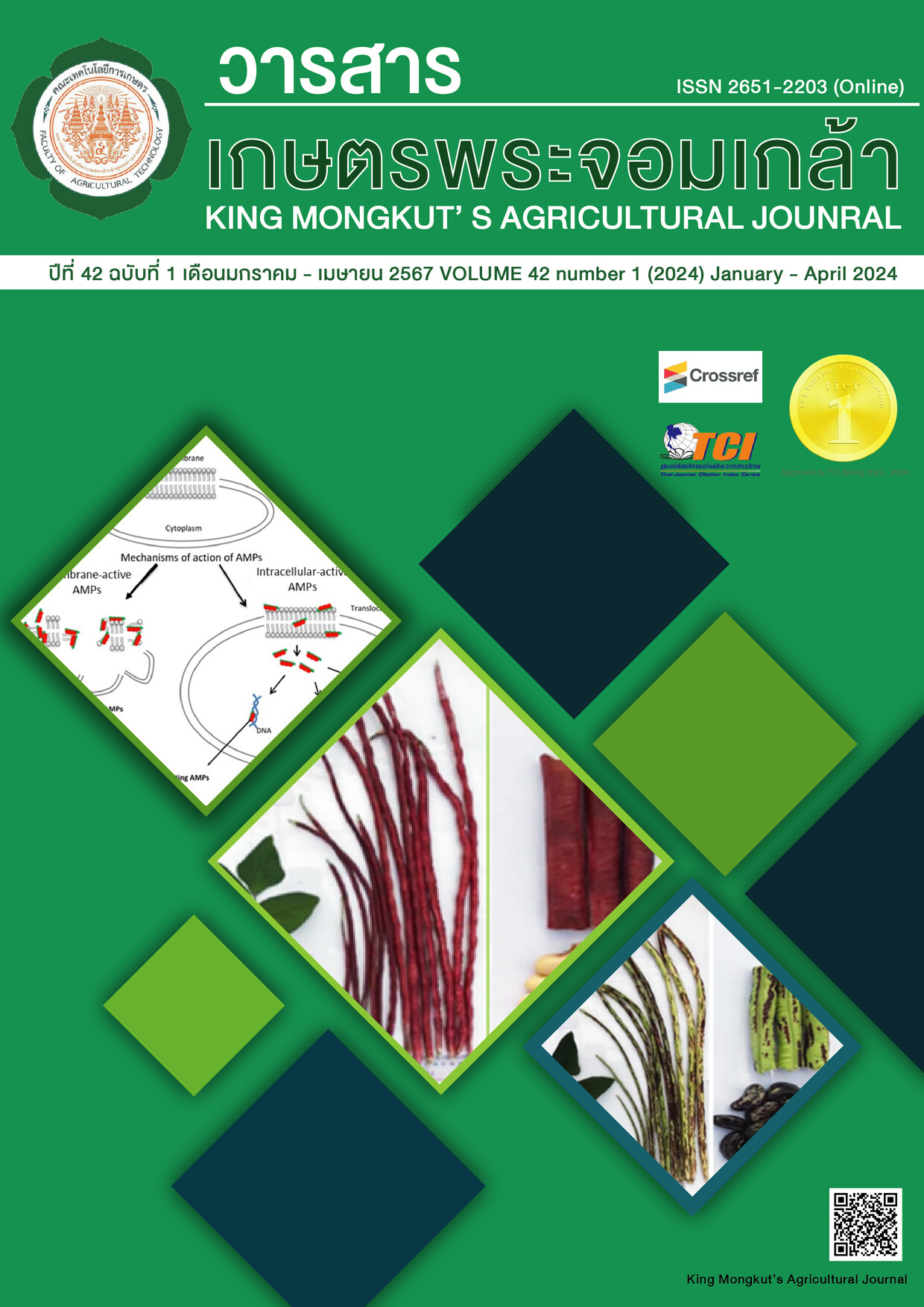กลยุทธ์การพัฒนาตลาดข้าวอินทรีย์ตำบลลวงเหนือ อำเภอดอยสะเก็ด จังหวัดเชียงใหม่
Main Article Content
บทคัดย่อ
การวิจัยนี้มีวัตถุประสงค์เพื่อสำรวจพฤติกรรมผู้บริโภคข้าวอินทรีย์ วิเคราะห์สภาพแวดล้อมและกำหนดกลยุทธ์การพัฒนาตลาดข้าวอินทรีย์ ต.ลวงเหนือ อ.ดอยสะเก็ด จ.เชียงใหม่ ในการเก็บรวบรวมข้อมูล มีการใช้แบบสำรวจพฤติกรรมผู้บริโภคข้าวอินทรีย์สำหรับผู้บริโภค 400 คน รวมทั้งใช้วิธีการสัมภาษณ์และการจัดประชุมกลุ่มย่อยกับเกษตรกรผู้ปลูกข้าวอินทรีย์และสมาชิกในครัวเรือน ผู้ประกอบการข้าวอินทรีย์ ผู้บริโภคในชุมชน และตัวแทนจากเทศบาลตำบลลวงเหนือ จำนวน 39 คน สำหรับวิธีการวิเคราะห์ข้อมูลจากแบบสำรวจนั้นใช้สถิติเชิงพรรณาโดยนำเสนอผลเป็นค่าความถี่และร้อยละ รวมทั้งวิเคราะห์ข้อมูลจากการสัมภาษณ์และการจัดประชุมกลุ่มย่อยโดยใช้วิธีการวิเคราะห์เนื้อหา และใช้ SWOT Analysis ร่วมกับ TOWs Matrix ในการกำหนดกลยุทธ์การตลาด ผลการวิจัยพบว่า พฤติกรรมการซื้อเฉลี่ยมากที่สุดของผู้บริโภค ได้แก่ ซื้อเดือนละครั้ง ซื้อเพื่อกิน กินเดือนละ 2-6 วัน กินเพราะอยากชิม ซื้อจากตลาดนัดในตำบล หาซื้อตามที่เพื่อนบอก ปริมาณการซื้อแต่ละครั้งอยู่ที่ 1-5 กิโลกรัม ซื้อแบบตักเป็นกิโล ซื้อในราคาที่สูงกว่า 35 บาทต่อกิโลกรัม และค่าเฉลี่ยราคาที่เต็มใจจะจ่ายอยู่ที่ 45.56 บาทต่อกิโลกรัม ส่วนผลการวิเคราะห์กลยุทธ์การพัฒนาตลาดข้าวอินทรีย์ พบว่ากลยุทธ์เชิงรุก ได้แก่ เพิ่มการประชาสัมพันธ์ พัฒนาแหล่งเรียนรู้ จัดอบรมด้านการสร้างมูลค่าเพิ่มข้าวอินทรีย์ ส่งเสริมการตลาดข้าวอินทรีย์ และสร้างกิจกรรมเรียนรู้การแปรรูปข้าวอินทรีย์ กลยุทธ์เชิงป้องกัน ได้แก่ ศึกษาเทคนิควิธีการรับมือกับการเปลี่ยนแปลงสภาพภูมิอากาศ สื่อสารเอกลักษณ์พันธุ์ข้าวอินทรีย์ ขยายเครือข่ายการตลาด และสนับสนุนการแปรรูปผลิตภัณฑ์ข้าวอินทรีย์ กลยุทธ์เชิงแก้ไข ได้แก่ พัฒนาการบริหารจัดการกลุ่ม เพิ่มช่องทางสื่อสาร แสวงหาทรัพยากรจากหน่วยงานรัฐ และวิเคราะห์ความต้องการของลูกค้า กลยุทธ์เชิงรับ ได้แก่ ทบทวนรูปแบบการผลิตและการตลาดข้าวอินทรีย์ รักษามาตรฐานการผลิตและแปรรูปข้าวอินทรีย์ วางแผนการสื่อสารและประชาสัมพันธ์ ควบคุมราคาผลิตภัณฑ์ข้าวอินทรีย์ที่เป็นธรรม
Article Details

อนุญาตภายใต้เงื่อนไข Creative Commons Attribution-NonCommercial-NoDerivatives 4.0 International License.
วารสารเกษตรพระจอมเกล้า
เอกสารอ้างอิง
Aekkakul, T. (2007). Research Methodology of Behavioral and Social Sciences. Rajabhat Ubon Ratchathani Institute. (in Thai).
Cheevit Thai Foundation. (2022). Update “Pay Money for Organic Rice Farmer” Budget 1,747 Million Baht. Retrieved from https://www.infoquest.co.th/2023/347772 (in Thai).
Economic news. (2023). Thai Export of Agriculture Goods Grows Continuously, Recommend to Extend Premium Market and Promote Value-Added of Goods. Retrieved from https://www.infoquest.co.th/2023/347772 (in Thai).
Lorchirachoonkul, V., Atthirawong, W., & Leerojanaprapa, K. (2018). SWOT and TOWS Matirx analysis for strategic development to increase Thai-Laos silk supply chain efficiency. Journal of Management Walailak University, 7(3), 15-26. (in Thai).
Maity, R., Sudhakar, K., Abdul Razak, A., Karthick, A., & Barbulescu, D. (2023). Agrivoltaic: a strategic assessment using SWOT and TOWS Matrix. Energies, 16(8), 3313.
Moslehpour, M., Kien, P. V., & Danyfisla, I. (2014). Differences of customer purchase behavior toward organic rice in Indonesia and Taiwan. International Journal of Quality and Service Sciences, 6(4), 348-368.
Phuapisit, P., Supadiluklak, R., Taiwan, A., & Chaiwan, W. (2015). Sustainable development of administrative management: case study in Wat Takien floating market. RMUTP Research, 9(2), 56-73. (in Thai).
Pipitkun, K. (2020). Organic agriculture, way to sustainable agricultural society: organic rice development strategy. Neuarj Neu Academic Journal, 10(1), 116-130. (in Thai).
Poosri, T. & Kungwansupaphan, C. (2020). Organic rice purchase behavior of consumers in the municipality of Surin Province. Journal of Management Science Research, Surindra Rajabhat University, 14(1), 1-13. (in Thai).
Pradit, K. (2018). The development of distribution channels of rice products through the electronic-commerce system for Bor-Khor’s housewife’s group, the community enterprise in Takbai District, Narathiwat Province. Academic Journal of Social Innovation, 2(12), 152-164.
Sameuajai, C. (2007). Consumer Behavior. 2nded. V Print Company. (in Thai).
Sinthusiri, N., Inthansang, C., Timtes Boonmasongsung, D., Nunnad, P., & Thongpracha, K. (2020). Distribution channel of organic rice processed product: case study of Nakornkong Jasmine Rice Community Enterpises, Nakhon Ratchasima Province. Academic Journal of Humanities and Social Sciences Burapha University, 28(2), 82-107. (in Thai).
Srijam, J., Koohasawanvate, S., & Rojnirutikul, N. (2015). Marketing mix in consumer decision for buying organic rice in Bangkok and metropolitan area. Journal of Industrial Education, 14(3), 697-704. (in Thai).
Sritong, O. (2016). Marketing strategy development of instant health supplementary rice: case study of cooperative women group in Klongluang (Klongsong). Journal of Graduate Studies, 10(1), 208-219. (in Thai).
Sukkarat, K., & Athinuwat, D. (2020). Study of consumption behavior and attitude of organic product consumer. Thai Journal of Science and Technology, 9(1), 68-76. (in Thai).
Taweesuk, T. (2015). Thai entrepreneur’s opinion on marketing mix strategy for organic rice. Journal of Suthiparithat, 29(92). 166-181. (in Thai).
Thisawet, R., Somboon, S., & Negi-Wichit, S. (2017). The strategies for development organic rice production system following self-sufficiency economy philosophy of the Ton-Kla enterprise of Amnat Charoen Groups. Humanities and Social Sciences Journal, 8(extra), 116-121. (in Thai).
Wu, W., Zhou, L., & Chien. (2019). Impact of consumer awareness, knowledge, and attitudes on organic rice purchasing behavior in China. Journal of Food Products Marketing, 25(5), 549-565.


